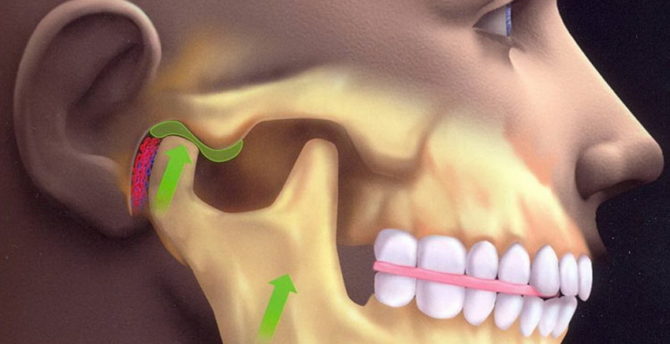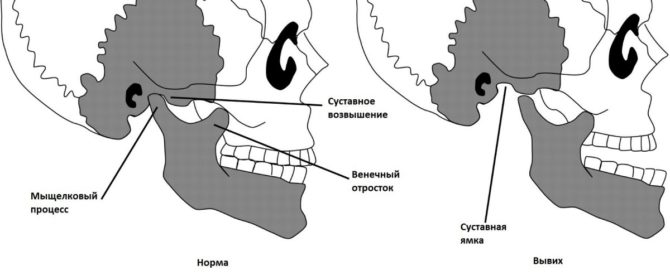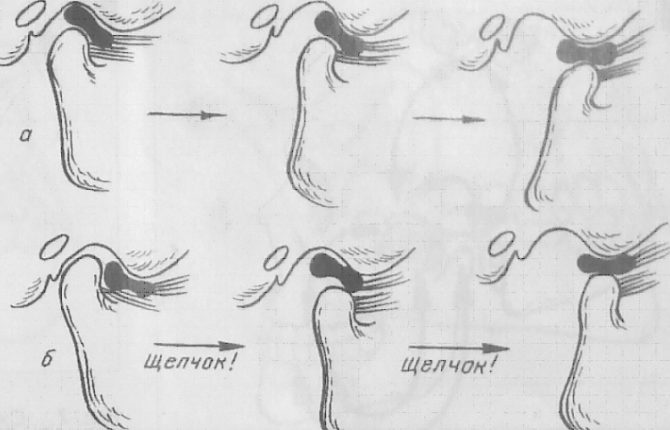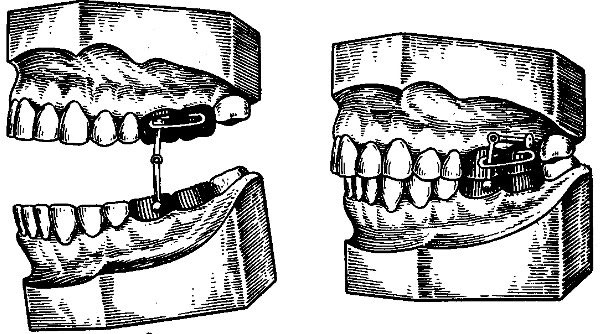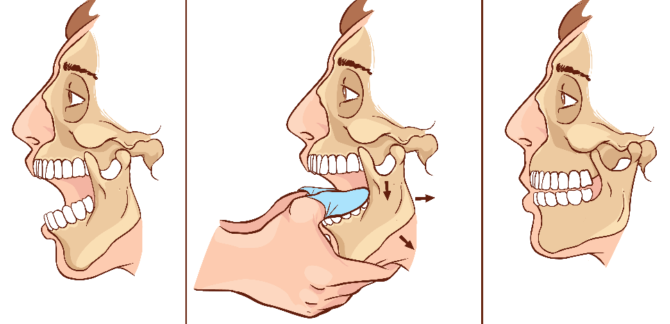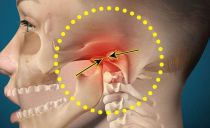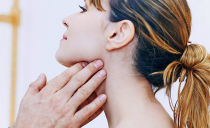Dislocation of the lower jaw: symptoms, treatment, how to straighten the jaw at home
The jaw joint has increased mobility, so it is relatively easy to dislocate. And this pathology is characteristic exclusively for the lower jaw, since the upper one is stationary by definition. Symptoms of a dislocation of the lower jaw manifest instantly, so the disease is easily diagnosed.
Content
Classification
All jaw dislocations can be classified according to various indicators:
| By the location of the articular head relative to the fossa (it is indicated which way it went) |
|
| By location: |
|
| By limitation period: |
|
| By severity: |
|
| By etiology: |
|
Any dislocation can and should be treated. Immediately after the incident, you must go to a hospital or emergency room to seek qualified medical help.
Causes
The jaw joint can be displaced spontaneously during yawning, vomiting, eating or screaming. Some patients go to the doctors because they dislocated their jaw, opening their teeth with bottles or any packaging. A little less often, the pathology arises due to medical manipulations: gastric sounding, gastroscopy and bronchoscopy. Sometimes dislocations occur during improperly performed extraction, which is especially characteristic for removing wisdom teeth.
An important place in the list of causes of mandibular dislocation is an external traumatic effect. Most often, the pathology is observed due to a direct blow to the face or a fall on the chin.
The causes of pathological or habitual dislocations of the jaw can be distinguished, since they are typical for patients with certain chronic pathologies and can arise due to minimal external impact. Diseases in which patients often dislocate the jaw joint include:
- rheumatism;
- gout;
- epilepsy;
- chronic arthritis;
- maxillary osteomyelitis.
With age, the ligaments of the jaw apparatus become weaker, the articular head is flattened, and the height of the articular tubercle decreases, which leads to disruptions in the TMJ and dislocations. Diseases that arose because the articular head came out of the fossa are called dislocations.
Due to the structural features of the skull bones in women, the usual jaw shifts, dislocations and subluxations occur more often than in men.
More details about the causes of acute and chronic pain in the jaw joint are described in the video:
Signs and associated symptoms of jaw dislocation
In some cases, the displacement of the dislocated lower jaw is visible to the naked eye, in others - only the patient himself suffers damage, those around him do not notice. The exact clinical picture of the disease depends on the type of damage, but there is a common symptom: each person with a maxillary dislocation feels a strong aching pain in the oral cavity and in the temporal bone, radiating to the ear from one side.
Usually, the moment of dislocation is accompanied by a characteristic click: the exit of the articular head from the fossa.
With a front dislocation, the embossed lower jaw extends slightly forward and sags. The victim has increased salivation (salivation) and difficulty speaking. He cannot close his mouth on his own, his face is distorted, his jaw is shifted to the side.
In the case of a posterior dislocation, the lower jaw moves back relative to the upper. Also, a temporary partial hearing loss is characteristic of the posterior dislocation of the jaw joint, since it sometimes causes a fracture of the wall of the ear canal with characteristic symptoms in the form of swelling in the ear zone.
With a bilateral dislocation, the mouth is tightly closed, it is almost impossible to open without external intervention. It becomes difficult for the patient to breathe (especially when lying down); he cannot find a comfortable sitting position.
Symptoms of mild jaw displacement include:
- sharp seal of the cheeks;
- chewing muscle tension;
- marked increase in salivation.
First aid
If you dislocate your jaw, do not make sudden movements, as they can lead to poor health. With severe pain, it is recommended to take any analgesic, but only if there is confidence in the absence of an allergy to its components. With this pathology, an increase in blood pressure and difficulty breathing are observed, and an allergic reaction to an unfamiliar drug will only worsen the condition.
Then you need:
- Fix the broken jaw in one position with a bandage from improvised means (as with any other stretching) to prevent it from shifting even more.
- Make something like a gag out of absorbent tissue to remove excess saliva.
- Call an ambulance. If there is no way to speak on your own, you need to ask the ambulance to call neighbors, passers-by or employees of nearby stores if an injury happened on the street. If there is a hospital nearby, it is better to immediately go to the emergency room of the medical facility.
Speaking with jaw injury is not recommendedas any mouth movements will be painful. Trying to straighten the jaw at home without appropriate practice is also not worth it.
Self-treatment of jaw dislocation, even if it occurred during normal yawning, can lead to prolonged articular dysfunction and damage to the fingers of the adjuster.
Diagnosis and treatment of jaw dislocation
Before treatment, a jaw dislocation should be distinguished by characteristic symptoms from similar diseases. Therefore, before the reduction of the dislocation of the lower jaw, doctors almost always carry out minimal diagnostics:
- study the medical history;
- collect and analyze the patient’s history;
- interrogate the patient's relatives;
- conduct physical examination and palpation of the damaged area;
- use methods of instrumental diagnostics: x-ray studies, MRI, CT.
Sometimes the diagnosis is only a visual examination of the patient, after which the traumatologist inserts the jaw joint into place.
Which doctor adjusts the jaw
Sometimes patients refuse hospitalization and try to insert a dislocated articular head into the fossa at home - such actions can lead to serious complications.
If you do not want to go to the hospital, you should come to the usual clinic. To which doctor to go with a dislocation of the jaw, the therapist on duty will say on the basis of the patient's condition and associated diseases. The victims are usually referred to a surgeon or traumatologist., but in special cases the therapist can correct the dislocation of the jaw independently. If the damage is minor, the adjustment will take just a few minutes.
Treatment methods
There are several methods of jaw reduction used by medical personnel:
- The Hippocratic Method. Most often, the jaw joint is displaced precisely with its help.
- Popescu Method.It is used only for the treatment of chronic injuries of the jaw apparatus.
- The Blechman-Gershuni method.
To restore joint function, special prostheses are used for temporary or permanent wear. Most often, for the purpose of reposition (reduction), patients are installed on the Petrosov apparatus, since it is convenient for daily use and inexpensive.
Muscle relaxants
When treating mandibular dislocation in a medical institution, the patient is given special muscle relaxants - medications that help relax the striated muscles and reduce muscle tone. Thanks to these medicines, the joint is fixed without disturbing the structure of the soft tissues.
Muscle relaxants have anesthetic effect, therefore to straighten the jaw in the clinic is not painful. But these drugs must be administered with caution due to the large number of side effects and contraindications.
Lack of proper anesthesia is one of the reasons why it is not recommended to try to insert the jaw into place on your own. When carried out at home, this process will be unpleasant, painful and long, although the jaw joint is usually inserted quickly.
How to straighten the jaw yourself
Dislocation of the jaw can be corrected at home, but only a person with relevant experience and / or medical education should do this. Insertion of the jaw joint at home should not be done by lay people. The following are general guidelines for the procedure. In any incomprehensible and emergency situation, it is better to call 03 - there are no jokes with skull bones!
To insert a dislocated articular head into the fossa, you must:
- Place the victim on a hard chair near the wall.
- Tilt the patient's head against the wall.
- Wrap the thumbs with a thick towel, as if the jaws slam shut, they can be damaged.
- Stand in front of the patient and ask him to open his mouth as wide as possible.
- Put your thumbs on your lower teeth.
- Grab your chin with your remaining fingers.
- With thumbs, push down on the teeth, and the rest - raise the chin.
- Quickly remove your fingers from your mouth or at least move them towards your cheeks.
- Insertion of the jaw will be accompanied by a characteristic click.
With bilateral dislocation, it is necessary to adjust each side separately, and with unilateral dislocation, try to put pressure only on the sore spot.
Yaw dislocation treatment for yawning
During yawning, usually there is not a full dislocation, but a subluxation that can be cured at home. To do this:
- Fix the jaw.
- Anesthetize the site of injury.
- Apply ice wrapped in a towel to the injury site.
- Hold ice for 5 minutes every hour.
Dislocation of the jaw joint can occur at any age and at any time, even with a yawn. If a pathology occurs, you should not try to cure it yourself, it is better to consult a doctor: he knows exactly what to do.
More details about the actions for dislocation of the jaw are described in the video:

